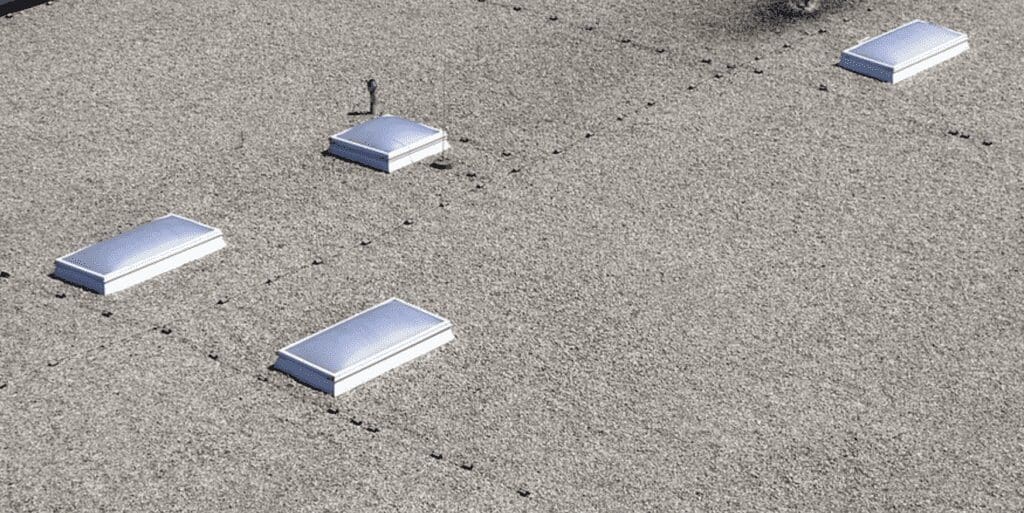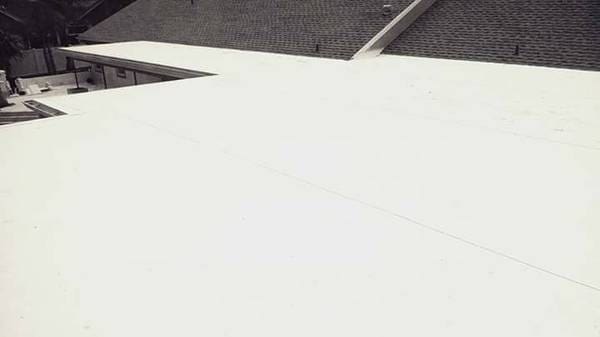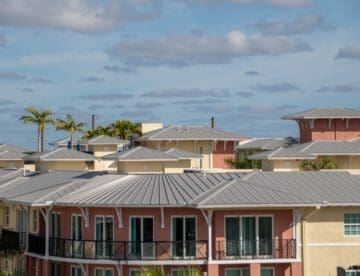Part 4: Materials for Flat Roofs
In the fourth segment of this series on “What’s the cost to replace my roof?” we’ll address the question: “What’s the cost to replace my flat roof?” As you might expect, you’ll have multiple options to choose from. For simplicity, we’ll group the options into three categories: membrane roofing, modified bitumen roofing, and built-up roofing (BUR). For the other articles in this series, you can read about asphalt shingle roofs, metal roofs, and tile roofs. Here’s another look at flat roofing, as well.
Your choice will depend on a few factors, such as the appearance you want and your budget. If you can see the new roof from certain rooms of your home, you might prefer the look of a particular product. But to be honest, none of these roof materials look great. If your existing roof has multiple penetrations, skylights, or parapet walls, those factors add to the complexity and cost. As for the cost, the cheapest will be an EPDM membrane. From there, the other options are comparable in their range, with a PVC membrane at the high end.
Membrane Roofing Options
A membrane roof comes in a few different materials, including TPO, PVC, and EPDM. These materials are more alike than different, in that they’re all installed over a layer of rigid insulation. Depending on the materials and your installer’s preference, they may be adhered with mechanical fasteners or adhesive. Here are the highlights of each type.
EPDM Roofing
This type of membrane roof is commonly used, as it’s a simple and proven material. The rolls are available in multiple widths, which can help to minimize the seams. And the seams are a prime drawback of EPDM, as they’re adhered with a cold-applied adhesive. Apart from storm damage, most leaks in EPDS roofs occur at the seams.
EPDM roofs are normally a dark color, which is a drawback in sunny Tampa, as well. An EPDM roof will get much hotter than a white or gray materials, and that heat can move into the house and create more work for the AC system. Finally, while an EPDM roof is the least expensive of the membranes, it also has the shortest life span. That may be up to 15 years, which is just half the lifespan of a PVC roof.
PVC Roofing
With substantial residential and commercial use for about 50 years, a PVC membrane roof is tried and true. It’s the most expensive of the membrane roofing choices, but can come with a lifetime warranty. The light color stays cool on hot, sunny days, and the seams are hot welded, not glued. This is a superior process that does not introduce fire risk, like some roofing installation methods.
TPO Roofing
TPO roofs are a newer type of material than PVC and EPDM, and the cost is mid-range. You might find that TPO splits the difference perfectly and gives you great longevity at the right price. We install TPO roofing because it’s easy to work with, the white color stays cool in Tampa’s hot sun, and it provides good longevity. Also, the seams are heat welded like PVC. There’s no adhesive that may fail over time, as with EPDM. You can expect your TPO roof to last 20 to 25 years.
Membrane Roof Pros and Cons
The advantage of all membrane roofs is also their drawback: a single layer. They go on quickly and are light in weight, but can’t provide the impact protection of a multi-layer roof. However, membrane roofs can be quite easy to repair when necessary, depending on how much water has infiltrated.
Built-Up Roofing (BUR)

This roofing system has a long history—more than 100 years of use. Also known as a “tar and gravel” roof, this system is heavy and requires robust framing to support the weight of the materials. A typical built-up roof uses solid insulation sheets over the roof sheathing. Then layers of of asphalt-impregnated roofing felt are rolled onto the surface and covered with hot tar. The top layer is usually gravel. This build-up of materials makes for a durable roof that can potentially withstand foot traffic and impacts better than a single-layer system like a membrane roof or a liquid-applied roof.
A BUR offers durability, but it’s heavy and the installation process is messy, smelly, and slow. Hot tar is not great to be around. These roofs can also be tough to repair, as finding a leak is challenging. Sometimes that means you will replace the entire roof so you can be certain of addressing the leaking spot. That said, a BUR system can sometimes be “renewed” with new layers, rather than completely replacing it.
A typical BUR roof will be mid-range in cost, and competitive with other material choices.
What Is Modified Bitumen Roofing?

This roof material is similar to and better than the old-school built-up roof (BUR). Like a BUR, the modified bitumen roof uses layers of asphalt and tar, but the improvement is the cap sheet. This synthetic top layer usually comes with a factory-applied granular coating, rather than using a layer of gravel. That makes the system lighter in weight than a BUR. You can also choose a light color to avoid the heat gain of a dark surface.
Compared to a BUR, you’ll see some tradeoffs. A modified bitumen roof will usually be a bit cheaper than a BUR, but also will have a shorter lifespan. It goes on faster, but is still slow and smelly.
What’s the Cost to Replace My Flat Roof?
Costs for different flat-roof materials are a bit less spread out compared to metal roofing and tile roofing. Each system will give you a range, but the cost for different materials can be quite similar. Here’s a handy review of the different materials and their cost.
We’re Here When You Need Us
If you’d like to talk about replacing your roof, give us a call at 813-373-9088. Our team has more than 40 years of experience in roofing. You can also use this form and ask us, “what’s the cost to replace my roof?” and we will contact you.
CLICK HERE FOR AN INSTANT ONLINE QUOTE IN 60 SECONDS
clear



